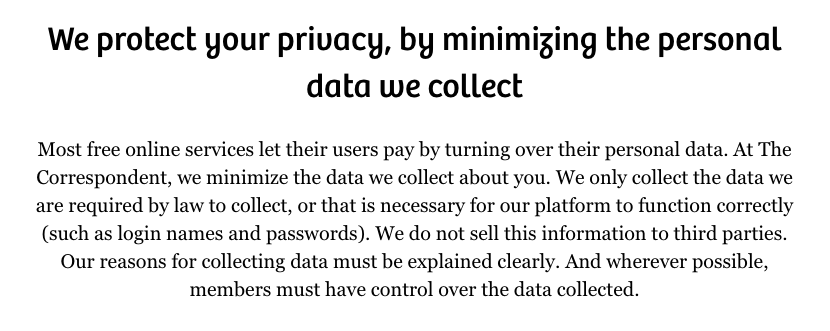Newsroom overview
A Dutch member-driven news organization that brings context to the news by rejecting the daily news cycle and collaborating with their readers.
De Correspondent
Amsterdam, The Netherlands
2013
2013
550,000
68,944
53.8 percent*
The Dutch news organization De Correspondent made a commitment from the beginning to collect as little data on their audience members as they could. In addition to an internally built CMS called Respondens, De Correspondent uses the “Google Analytics alternative” Matomo.
Data analyst Daan Aerts explained that information from Matomo cannot be traced back to an individual person, but that anonymized aggregated information includes details like pageviews and homepage visits, country-level location, and sign-up page actions. Location information doesn’t get more specific than city-level, and the company uses a visitor’s full IP address to determine his or her location before stripping off the last digits and storing the address. There’s no tracking of visitors across their devices.
Member-specific information can be used to internally understand information including how much on-platform conversation an individual article has generated, new member reach, and average member financial contributions. Aerts adds, “I benefit from a well-designed data governance plan. In my work, I never come across identifiable information about our members. Within our organization, people have access to data on a need-to-know basis.”
In the U.S. the investigative news organization The Markup similarly limits its collection of reader data, partially informed by De Correspondent’s approach.
*95 percent of De Correspondent’s revenue came from readers in 2019. The remainder came from book sales and donations.
Why this is important
Nearly every online interaction we have – shopping, reading, socializing – is tracked. At a time when this has become standard across the industry, many individuals are concerned about their digital privacy and footprints. As detailed in one of the more human, readable examples of an organizational privacy policy, De Correspondent limits what it collects both on principle and in practice.
As their sister English language news organization The Correspondent details in their member compact, privacy and audience revenue don’t have to exist in tension with each other. And the organizations stands out in being forthright in their intentions in this regard, telling readers, which helps build trust.

What they did
Most De Correspondent members are located in the European Union or the European Economic Area, and are protected under the General Data Protection Regulation (GDPR). But it isn’t the only reason that De Correspondent has committed to collecting minimal data.
Over seven years of publishing, De Correspondent has seen that its current and prospective members don’t just say they care about how their privacy is treated on site – they truly want to know the organization’s policies with regards to their own information. As shown below, the company provides more details on the handling of user data than many of its peers.
These practices are also detailed in the privacy and cookie statement on The Correspondent and shared here in English. (Note that under US law, where many members of The Correspondent reside, unfair or deceptive uses of data are unlawful. Beyond that, federal privacy laws vary by the type of data or marketing used and also vary by industry. The Correspondent’s policies are voluntarily and comparatively conservative in terms of what data the company collects, as detailed below.)
More information regarding the handling of member information is as follows from the public privacy and cookie statement. Note the sentence “we also use all of this data to gain insight [in]to the reading preferences of our members (in legal terms, because we have a legitimate interest to do so)”:
The results
While it may be harder to “know” members without having much data about them, De Correspondent has been able to get the information it needs to design smart editorial products and cultivate loyalty through voluntary audience research.
Part of that comes down to their decision to invest more in editorial and membership staff. For most of its existence De Correspondent has not employed full-time data analysts. Aerts became the organization’s first data analyst in 2019 and works on the three-person membership team alongside a strategist and membership director. (Conversation and engagement editors work in parallel from within the editorial department.)
Aerts has spent the past 18 months building dashboards and synthesizing membership data, as well as creating self-service tools for the organization, including a “Daily pulse” Slack channel – an automated Slackbot that provides organizational clarity into how membership is growing or stagnating compared to goals.
De Correspondent cofounder and CEO Ernst Pfauth said that with this work the organization is still following its principles and anonymizing user data, but presenting it better internally for cross-team intel. Pfauth said that the days are past when, “If I wanted to know something about churn, for example, I had to ask a developer [and] a developer made a query and then they showed it to me. And now by building these dashboards [we’re] making the data more accessible to everyone.”
Relevant information is also distributed in a weekly member email and monthly presentations to all staff.
What they learned
Prioritizing privacy does not mean you will be data poor. Mayke Blok, Aerts’ teammate and membership strategist at De Correspondent and The Correspondent, told MPP: “We believe that you can often get sufficient information without collecting huge amounts of data from your members. There’s always a way to work around not having all the metrics available. You can use surveys, or ask the questions you have in a different way.” For more information on De Correspondent’s surveying practices with members, jump to MPP’s case study on how De Correspondent collects qualitative insights about its members.
Blok said that the membership team is regularly coming up with questions about its members, such as how important the first 30 days of a membership are to their willingness to keep supporting the publication, and considers those insights along quantitative data.
“To answer that question we looked at cohort data, but also implemented a survey that provided us with a lot of context. You need to contextualize the numbers you do have, instead of falling into the rabbit hole and just keep trying to find out more by collecting more and more data,” Blok said.
It’s not just about not collecting as little data as possible, it’s about making sure it’s used only for the right purposes. Protecting users’ privacy is also about making the right choices with the data you do have access to. Aerts offers an example: Technically, De Correspondent could tell who is very interested in journalism about LGBTQ issues and use that a number of ways. But De Correspondent opts to use that data only to show someone their “recently read” stories.
Key takeaways and cautionary notes
It’s possible to maintain user privacy while collecting meaningful data for product decision-making. De Correspondent collects data including time on site, bounce rate, visits per visitor (according to cookies), e-commerce sales, and events like clicks on menu items and comments, all of which they track anonymously. Compared to other digital news organizations, this is a low amount of information – something its members value greatly.
Other resources
- The Correspondent, resource: The Correspondent’s Principles
- The Markup, resource: Ethics Policy
- Membership Puzzle Project, research: The Correspondent became the most participatory journalism crowdfunding project in history without one story on its site. Here’s how
Disclosure: De Correspondent was a founding partner of Membership Puzzle Project.


